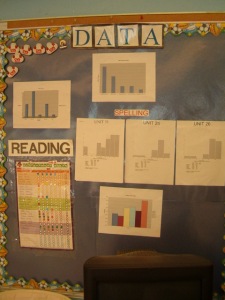
Assessment Data …. If you’re within listening distance of a classroom you’ve probably heard the words. The words can hold positive as well as negative connotations. Two different types of data are often used in the classroom – summative and formative. I think this picture helps show the difference between the two. If used appropriately, formative assessment data (exit card, common assessment, observation, journal, data binder, etc.) can be used to improve student learning. Many teachers that I’ve met through Twitter utilize formative or local assessments to maximize student learning. I believe that it’s possible to use student achievement data to identify specific strengths/concerns as well as assist teachers in developing interventions (remediation/enrichment) for students.
At times the word is also associated with standardized test scores and accountability. Those words combined might make a few teachers cringe and organizers protest. A school district’s standardized test scores may make news headlines and influence school improvement plans. The emphasis on standardized testing has caused teachers to allocate more time for test prep. Some districts begin the test prep process in January, or before, when the test actually occurs in March. That test prep time takes away time from many non-test related subject areas.
I’ve been told that the Common Core will change the standardized testing landscape. I can’t predict the future, but I believe standardized test scores will continue to dominate local and national headlines. It’s been well documented that there’s an overemphasis on standardized test scores in public schools in America. The emphasis on test scores impacts teacher instruction and will soon influence teacher evaluations. Is this a good thing?
I’m not advocating for or against standardized assessments, but I believe formative assessments should drive academic differentiation decisions in the classroom. Even though the overemphasis on standardized test scores seems to be the norm, I’m optimistic. Why? Many influential education leaders are starting to notice the impact of standardized testing on students, teachers, communities, and administrators. The leaders below are speaking out on the impacts of standardized testing. Feel free to follow the courageous people below.
- Joshua Star @mcpssuper is the superintendent of MCPS, a large, diverse, and high performing district in Maryland. He has concerns over the validity of standardized tests and has asked for a moratorium on standardized testing.
- Diane Ravitch @dianeravitch, is Research Professor of Education at New York University, wrote a blog post about the inequalities of standardized testing here.
- Larry Ferlazzo @larryferlazzo, an ESL teacher in California, wrote a blog post comparing the difference between being data-informed and data-driven.
